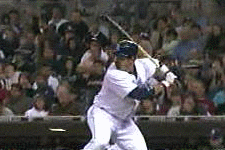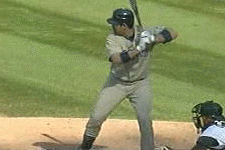1) Low outside pitch locations. Do they give hitters problems because the fused upper body is lost sooner? Farthest distance away from hitter. Hitter is not near as tight as he would be on a waist high pitch down the middle. Would setting up lower in your stance help you handle the LOP? If so does that create a different location problem?
2) Continuous pullbacks on any outside pitch or off speed is the key to success. I have also noticed a tad bit longer stride on outside pitches. Does this aid the hitter in letting the ball travel deeper? Are the pullbacks helping make the stride longer? Have seen the reverse effect on inside fastballs (shorter stride). If so the rear leg has to be rock solid in order to contol stride length. Must get on top of rear leg. If the hitter does not have enough weight on the rear leg it would hender using the stride as an adjustment. Or is the stride always the same length?
All feedback welcome.
2) Continuous pullbacks on any outside pitch or off speed is the key to success. I have also noticed a tad bit longer stride on outside pitches. Does this aid the hitter in letting the ball travel deeper? Are the pullbacks helping make the stride longer? Have seen the reverse effect on inside fastballs (shorter stride). If so the rear leg has to be rock solid in order to contol stride length. Must get on top of rear leg. If the hitter does not have enough weight on the rear leg it would hender using the stride as an adjustment. Or is the stride always the same length?
All feedback welcome.







Comment